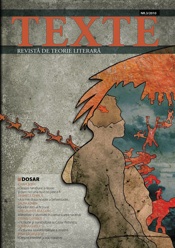
Texte - Revista de Teorie Literara, n°3, Green Art Line, 2010.
The intercultural project “Texte” is a complex endeavor, aiming to create a literary theory centre.
In the Romanian cultural field literary theory is quite underrated, both in the critical and intellectual community and in the university system. Thus, the project has the responsibility to go against this tendency and to give literary theory its rightful place, as a necessary instrument of cultural discourses. Therefore, the stakes of the Texte project are high and essential to raising awareness and encouraging accuracy in the Romanian intellectual field.
The Texte Literary Theory website: http://www.revistatexte.greenartline.ro
The literary theory quarterly Texte [ Magazine ]
The magazine is a marketable means of developing and promoting literary theory. This is the best way to be present in both universities and on the market with theoretical studies and book reviews. The magazine gives us the opportunity to recruit and train students or people interested in literary theory. The content, made of quality theoretical articles, is the work of the editorial body which includes the most important Romanian theoreticians of the moment.
The Texte quarterly is lead by a team sharing an interest in the theoretical phenomena and their influence on the literary and cultural field.
Texte Magazine no. 3 Abstract:
The theme of the third issue of Texte is “Fiction and narrative strategies”. Apparently heteroclite, this issue's articles mainly allow the concepts to glide and propose new interpretations. Thus, Ioana Bot discusses theory and narrative in Laurent Jenny, for whom narrative structures are primarily ways to domesticate reality, they are keys to representations, comprehension and demonstrations. When a theoretical, abstract discourse, resorts, however, to narrative structures, these represent openings for a rhetorical reading of the critical texts and, why not, for the foundation of a stylistics of critical texts. On the other hand, Gabriela Chirila's article discusses the theories of “life as fiction” and the truth, reactivating Scheherazade's story and its rewriting by E.A. Poe. Gheorghiţă Răileanu's essay discusses fiction in the artificial narrative frame. The theoretical apparatus of the concept of fiction is analysed, stressing two major tendencies: one to reify the concept, through theoretical glosses and the other, based on problematization, staying close to the literary material. Laura Marin asks herself what fiction is and where it begins, in an article about Maurice Blanchot's writings, starting from the experience of the voice. The latter becomes an object of literary theory and the writing, its manifestation. Writing is a whisper of the language and these whispers and subtle vibrations allow us to sign the contract with fiction. Ştefan Dărăbuş uses some texts written by Cezar Petrescu in order to shape the various literary mutations at the beginning of the 20th century. His hypothesis is that Author, Reader and Text communicate at various levels. In Cezar Petrescu's novels, all these hybridizations and boundary violations represent a very modern approach and they indicate not only his originality but also his visionary creativity. Sorana Ghitea in “Fiction, our alternate reality” draws a parallel between the slippery levels of fiction and reality, by destabilizing theories, while Irina Georgescu, in the article “Intertextuality and narrative voices”, claims that the text survives on registering the harshness of the tone, on irritating, on hiding and becoming resistant to interpretation. Its visceral frame puts forward the body drama, the incapacity and anguish, while authenticity parallels limit experiences.
In this issue we interview Professor Carmen Muşat, who has constantly focused on the narrative mechanisms and the fictional frameworks of postmodernist writers, on the dynamics of the novel and the fragile relation between fiction and history. The questions revolve around key issues regarding fiction and narratives, and their problematic relations with history, autobiography, facts, science fiction, mimesis and so on.
Gabriela Jugănaru, student at the “I. L. Caragiale” Film Academy, the Multimedia section, writes about both the screening of Bernhardt Schlink's The reader and the novel, first person narrative versus cinema objectivity, thoughts versus images, experience versus spectacle.
Alexandra Florescu deals with defining the concept of epistemocritics, a new interdisciplinary approach to literature in relation with the scientific discourses.
Among the titles reviewed are Istoria corpului (vol. I discussed by Professor Alexandru Ofrim, and volume II by Ioan Tomoiagă, graduate of “ Babeş Bolyai “ University in Cluj), Rămas-bun literaturii by William Marx (Ioana Hora, student at the University of Cluj), Arta romanului by Milan Kundera (Diana Câmpeanu, student at the University of Bucharest), Gândirea romanului by Toma Pavel (George Neagoe, The Literary History and Theory Institute, Bucharest), Anxietatea influenţei by Harold Bloom (Romulus Mînecan, graduate of the University of Cluj), Teoria literară by Terry Eagleton (Mirela Tomoiagă, Cluj University), Errata by George Steiner (Ştefan Dărăbuş, graduate of the University of Cluj).
To sum up, this issue expresses our interest in the validity of the theories about fiction and the necessity for new approaches, such as fictional strategies, mimetic topicality, the threshold between fiction and non-fiction, as well as the shift of the author or the mimetic fictional pact.